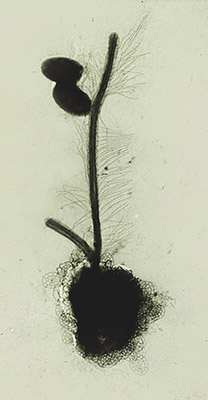|
Hyphochytrid
Hyphochytrids are eukaryotic organisms in the group of Stramenopiles (Heterokonta). Characteristics They are distinguished by an anterior tinsel flagellum on their zoospores. Also they have a rhizoidal or hypha-like vegetative system (hence the prefix "Hypho-"). Classification This group may be put alternatively at the phylum, class, subclass or order level, being referred to as Hyphochytriomycota, Hyphochytriomycetes (or Hyphochytrea), Hyphochytriomycetidae (or Hyphochytridae) and Hyphochytriales, respectively. The variants Hyphochytri''di''omycota and Hyphochytri''di''omycetes are also sometimes used, presumably by analogy to the Chytridiomycetes, or due to the perpetuation of a typographical error. However, the stem is Hyphochytri- (from '' Hyphochytrium'') and not Hyphochytridi- (from ''Chytridium''). In the past the classes Hyphochytridiomycetes, Oomycetes and Chytridiomycetes were grouped together in the now obsolete taxon Mastigomycotina as fungi with flagellate spores o ... [...More Info...] [...Related Items...] OR: [Wikipedia] [Google] [Baidu] |
Stramenopiles
Stramenopile is a clade of organisms distinguished by the presence of stiff tripartite external hairs. In most species, the hairs are attached to flagella, in some they are attached to other areas of the cellular surface, and in some they have been secondarily lost (in which case relatedness to stramenopile ancestors is evident from other shared cytological features or from genetic similarity). Stramenopiles represent one of the three major clades in the SAR supergroup, along with Alveolata and Rhizaria. Members of the clade are referred to as 'stramenopiles'. Stramenopiles are eukaryotes; since they are neither fungi, animals, nor plants, they are classified as protists. Most stramenopiles are single-celled, but some are multicellular algae including some brown algae. The group includes a variety of algal protists, heterotrophic flagellates, opalines and closely related proteromonad flagellates (all endobionts in other organisms); the actinophryid heliozoa, and oomycetes. T ... [...More Info...] [...Related Items...] OR: [Wikipedia] [Google] [Baidu] |
Mastigomycotina
Mastigomycotina is a former polyphyletic taxonomic grouping, a subdivision, of fungi, similar to Phycomycetes, and that included the zoosporic classes Chytridiomycetes, Hyphochytriomycetes, Plasmodiophoromycetes and Oomycetes. General features of Mastigomycotina:Wong, G. J.: Classification of Fungi'. URL last accessed 2007-04-03. * They produce flagellated cells during their lifetime. * May bear rhizoids. * Mostly, filamentous and having coenocytic mycelium. * Show centric nuclear division. * Perfect state of spores is typically oospore An oospore is a thick-walled sexual spore that develops from a fertilized oosphere in some algae, fungi, and oomycetes. They are believed to have evolved either through the fusion of two species or the chemically-induced stimulation of mycelia ...s. See also * Fungus-like organisms References Obsolete fungus taxa {{fungus-stub ... [...More Info...] [...Related Items...] OR: [Wikipedia] [Google] [Baidu] |
Zoospore
A zoospore is a motile asexual spore that uses a flagellum for locomotion. Also called a swarm spore, these spores are created by some protists, bacteria, and fungi to propagate themselves. Diversity Flagella types Zoospores may possess one or more distinct types of flagella - tinsel or "decorated", and whiplash, in various combinations. *Tinsellated (straminipilous) flagella have lateral filaments known as mastigonemes perpendicular to their main axis, which allow for more surface area, and disturbance of the medium, giving them the property of a rudder, that is, used for steering. *Whiplash flagella are straight, to power the zoospore through its medium. Also, the "default" zoospore only has the propelling, whiplash flagella. Both tinsel and whiplash flagella beat in a sinusoidal wave pattern, but when both are present, the tinsel beats in the opposite direction of the whiplash, to give two axes of control of motility. Morphological types In eukaryotes, the four main types ... [...More Info...] [...Related Items...] OR: [Wikipedia] [Google] [Baidu] |
